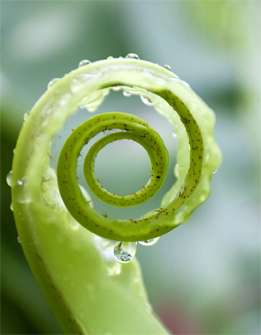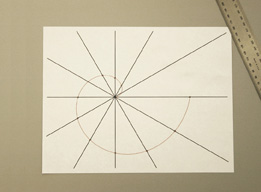Lesson 2
1. Lesson 2
1.4. Discover
Module 1: Sequences and Series
Discover

© foto76/24001220/Fotolia
Look at the unfurling fern tip in the photo. How would you describe the fern tip's shape? The spiral is found everywhere in nature. Besides the shape of fern tendrils, the spiral is also found in these places in the animal kingdom: a giraffe's intestine, a centipede's death pose, and a butterfly's tongue.
How do spirals relate to arithmetic sequences? Prepare to find out in the following Math Lab. You will investigate Archimedes' Spiral, one of the simplest spiral forms.
Problem Question
How are arithmetic sequences related to linear functions?
Materials
You will need
- a ruler
- Archimedes' Spiral Template
- a pencil
Hypothesis
Form a hypothesis to answer the problem question. Do you remember what a hypothesis is? ![]()
Procedure
Step 1: Print a copy of Archimedes' Spiral Template, provided in the Materials list.

Step 2: Identify the points along the spiral that intersect the radii (or spokes) of the circle. Mark these with small dots.

Step 3: Use your ruler to measure the length from the centre to the first point of intersection with a spoke as you wind from the centre to the outer edge. Repeat for each intersection point as you continue from the centre and radiate outward. Once you have 12 data values, record your measurements to the nearest millimetre in a table like this one. Then proceed to Analysis.
Radius |
1 | 2 | 3 | 4 | 5 | 6 | 7 | 8 | 9 | 10 | 11 | 12 |
Distance to Intersection |
Analysis
- Study your measurements. What kind of sequence do your measurements form? What is the common difference?
-
- Determine an expression of the form tn = a + (n − 1)d for the sequence. Simplify the expression.
- What does n represent in this expression?
- What does tn represent in this expression?
- Does the simplified form of the expression remind you of any other expression?
- Determine an expression of the form tn = a + (n − 1)d for the sequence. Simplify the expression.
- Plot a graph showing tn versus n.
- Do you think the points should be connected? Why or why not?
- Describe the type of function that is represented by the graph?
- What property of the sequence corresponds to the slope of the graph?
How do your results compare to your initial hypothesis?
![]() Save your results in your course folder.
Save your results in your course folder.
You will use your results again later in the lesson.
